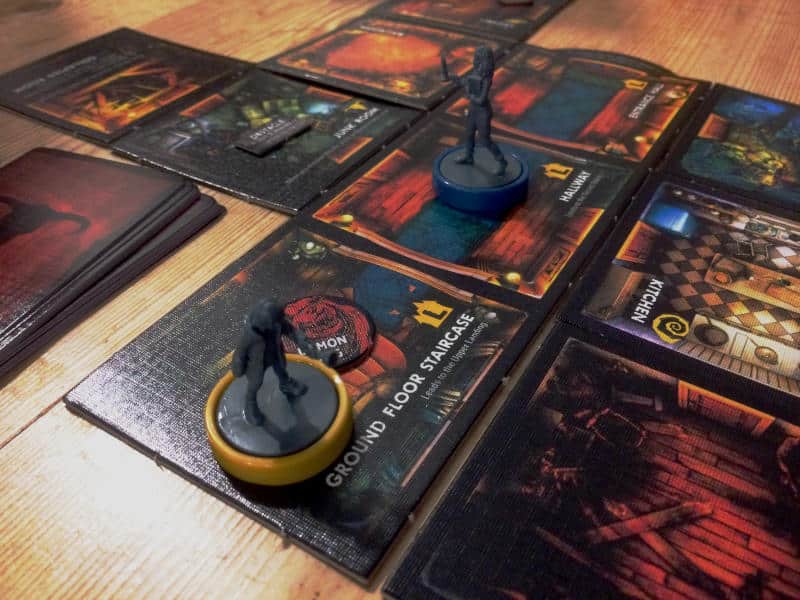Sometimes I want to become the character on my player board, living out their adventure and experiencing a dramatic story filled with excitement and suspense. Other times, I just want to move some wooden pieces across a plain board, while I am deep in thought, and a giant decision tree that’s unfolding further with every turn fills my mind. Sometimes I yearn for a thematic experience, other times I crave something purely abstract. So in this article, I want to look at how these two board game categorisations shape the gameplay experience.
Listen to the Audio Version
Intro Music: Bomber (Sting) by Riot (https://www.
Music: https://www.
License code: HAGPZN8QVBH9PRLB
Artist: : Lunar Years
Music by Bensound
License code: C6OWWPO2VLQBAOCS
Artist: : Theatre Of Delays
Music I Use: https://www.
License code: LRJMMDLS915XVZ4C
Artist: : Vital
Music by https://www.
License code: RSJQEDEJQHLOGU0U
Artist: : The Fable
Immersive Settings
A game’s setting is what bridges the gap between the player’s real world and the world of the game. A game’s setting is the time and place where the story unfolds. It can be physical locations that are represented in the game, a game’s cultural context, or the historical era it is placed in. When a setting draws you in, you begin to see yourself as part of the game’s story. That story could follow a well-known genre, such as sci-fi or historic fiction, which is manifested through evocative illustrations, narrative text, or amazingly sculpted miniatures. Whatever it is, it somehow ignites your imagination and allows you to forget the real world around you – at least for a while.
The immersion also influences how you interpret decisions and events happening in the game. A strong setting is not merely decoration. It somehow transforms an ordinary set of mechanisms into choices that feel meaningful and important. It heightens the sense of drama and increases the stake you, as the player, feel you have in the game. When a game’s rules, narrative text, artwork and components work together and support the story, the immersion will be complete, waiting for the player to allow themselves to forget everything around them and enter the world of the game.
However, settings can be overdone. Elaborate backstories and too many rules exceptions can really slow down gameplay. While some players enjoy the extra details and edge cases, many want to just play the game, without too many rules or other details getting in the way. When the story overshadows the rules system, it risks breaking the rhythm. The difficulty of designing a strong setting that is just right lies in the way it invites players into the game’s world, without burdening them.

Betrayal at House on the Hill as an Example
Take Betrayal at House on the Hill, for example. Mechanically speaking, this is a tile-laying game that shifts from cooperative exploration to a one-versus-many boss fight as soon as a dice roll hits a certain threshold.
Yet, when you play the game, you don’t feel those mechanisms. You don’t think about them. All that happens is that you go from feeling safe with your fellow players to suddenly feeling betrayed. Not only that, you start to worry about what the cursed player’s powers may be. You are still part of the team and enjoy their relative safety, but you’re scattered around the house, and you sort of have to fend for yourself.
As the cursed player, you wonder how you will be able to win single-handedly with the powers you were given. You feel lonely and lost, but you also glimpse the supernatural strength you have to beat the other players around the table. Many people don’t want to be the cursed player, which emphasises the feelings that the game wants to evoke.
So a very simple change, going from cooperative to one-versus-many, creates a strong emotional shift that reinforces the story. The immersiveness of the game also allows players to ignore the randomness of the dice rolls and the tile draw. These events don’t feel like pure chance. Somehow, they take on a certain meaning. They become part of a shared fiction that players tell each other as the game progresses. It feels like there is a reason for what happened, and as the story unfolds, earlier events suddenly seem to have an obvious cause. It was all almost determined to turn out as it had.
Abstract Clarity
Abstract strategy games take a very different approach. They strip away story completely to leave a set of well-defined mechanisms. When an abstract game also has minimal luck, only logic is left, leaving no room for any narrative. Players have all the information in front of them. Every decision can be analytically evaluated, without players ever looking at the game from a fictional character’s perspective. Players don’t compete as characters in a game, but through their direct player interactions.
The satisfaction of playing abstract games comes from reading patterns, predicting moves, and improving your strategy over time. Abstract games reward good planning and a clear, calculating mind. A great abstract game lets players speak through elegant moves and clever plans. Their actions speak a thousand words. Players lead a dialogue with every turn they take, a dialogue that doesn’t need fancy words or clever phrasing, but has a sort of mental elegance. That can make abstract games sometimes feel a bit elitist, but modern abstract games have disproven that assumption.
Games like Hive are not only for clever-clogs with an IQ of 100. They create tension through structure rather than story. While they do have a setting, it’s rather shallow and mostly there to appeal to a wider audience. They show that you don’t need a narrative to feel pressure. As tension builds and turns become tighter, the gameplay arc goes up and up, until eventually, one player makes a mistake or finds a clever action and wins the game.
Designing abstract games isn’t easy. You can’t hide behind a great story or beautiful illustrations. Every rule must serve a definitive purpose. When done well, the result is beautiful in its simplicity, like a fine sculpture carved from the purest logic.

And Everything in Between
Of course, many games fall somewhere in between having a strong setting and being purely abstract, as I already indicated when I talked about Hive. Designers like to blur the line between abstract systems and a strong sense of setting. The result is an in-between space where many modern board games offer a balance between emotional engagement and strategic depth, which allows these games to appeal to a wider audience.
Games like Concordia use Roman trade as a setting, but the experience feels like an optimisation puzzle. The setting adds context, but the strategy is the focus. The rules do not simulate life in the Roman Empire, but they create a tight, deterministic game that rewards clever planning, with a bit of randomness thrown in. Root offers cute artwork and asymmetric factions, but under the surface, it is a tight, rule-driven conflict simulation game. While many people are drawn in by the cuddly factions, it is much more like a game from the COIN series. The game’s mechanisms are much more important than its story, even though both really matter.
Even Chess hints at a setting, of course. There are kings, queens, bishops, and many other named pieces. These names shape how players imagine their actions. They help put an intuitive value on every piece. The game remains abstract, but it is easy to imagine it as a war game played with tin soldiers. While the pieces’ movement is abstract and rigid, you still get a sense of the threat your king is under as the other player manoeuvres you into a tighter and tighter space. You can almost hear the approach of the cavalry and the shouting of the pawns and see the whites in their eyes.
A Place for Every Player
Some players want the best of both worlds. They want drama, but also feel in control. So games that combine strategic depth with story elements can show that setting and abstraction are not opposites, but equally useful tools to design board games. You can put them together and mix them in whatever ratio needed to create the desired gameplay experience.
Whether you prefer highly imaginative stories or clearly defined, highly logical puzzles, what is amazing about playing modern board games is that they can offer both. Some days you might want to play the role of a brave adventurer, at other times you just want to focus on an abstract puzzle. Both types of games are equally valid, and both serve different moods or needs, or even player groups. As players, we benefit from the mix of abstraction and strong settings. Board games can have an evocative setting or be elegantly simple – or both.
Ultimately, what matters the most is how board games can connect people through a shared experience. Whether that experience comes from flavour text or the game’s abstract form is much less important than how it makes us feel when we play the game. It’s very valuable when a game brings people together around a table and either invites us to dive into a different world, wants us to focus our logical brain on a challenge, or gives us an interesting mix of both. Whatever you choose, the journey is yours to enjoy.
Keeping the blog running takes time and resources. So if you can chip in, that would be amazing.
Useful Links
- Betrayal at House on the Hill review: https://tabletopgamesblog.
com/ 2023/ 01/ 14/ betrayal-at-house-on-the-hill-3rd-edition-saturday-review/ - Root review: https://tabletopgamesblog.
com/ 2022/ 02/ 12/ root-a-game-of-woodland-might-and-right-saturday-review/






